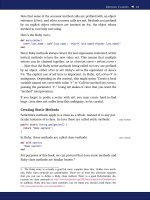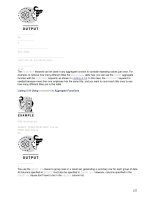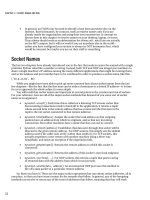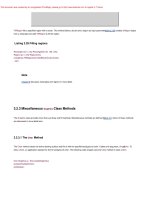head first java programming phần 3 docx
Bạn đang xem bản rút gọn của tài liệu. Xem và tải ngay bản đầy đủ của tài liệu tại đây (1.51 MB, 44 trang )
you are here 4 55
textual data
Which of the above methods do you need to use to locate the
price substring within the Beans’R’Us web page?
text.endswith(".jpg")
Return the first index value when the given substring is
found.
text.upper():
Return a copy of the string converted to uppercase.
text.lower():
Return a copy of the string converted to lowercase.
text.replace("tomorrow", "Tuesday"):
Return a copy of the string with all occurrences of one
substring replaced by another.
text.strip():
Return a copy of the string with the leading and
trailing whitespace removed.
text.find("python"):
text.startswith("<HTML>")
Return the value True if the string has the given
substring at the beginning.
Return the value True if the string has the given
substring at the end.
What the method does
Method
These are some of the many built-in string methods that come with
Python. Match each method to what it does. We’ve done one for you
already.
56 Chapter 2
find, the right method
Which of the above methods do you need to use to locate the
price substring within the Beans’R’Us web page?
What the method does
Method
The “find()" method
text.endswith(".jpg")
Return the first index value when the given substring is
found.
text.upper():
Return a copy of the string converted to uppercase.
text.lower():
Return a copy of the string converted to lowercase.
text.replace("tomorrow", "Tuesday"):
Return a copy of the string with all occurrences of one
substring replaced by another.
text.strip():
Return a copy of the string with the leading and
trailing whitespace removed.
text.find("python"):
text.startswith("<HTML>")
Return the value True if the string has the given
substring at the beginning.
Return the value True if the string has the given
substring at the end.
These are some of the many built-in string methods that come with
Python. You were to match each method to what it does.
SOlUTion
you are here 4 57
textual data
You need to update your price-grabbing program so that it extracts the four-character substring
that follows the occurence of the “>$” characters. Write the new version of your code in the
space provided.
Hints: Don’t forget that the find() method finds the starting position of a substring. Once
you’ve found “>$”, use Python’s addition operator to calculate where in the string you want to
extract the substring. The addition operator is the “+” symbol.
coffee beans = <strong>$5.49</
strong></p><p>Price valid for
Search for this 2-character
combination.
Here’s what
you’re really
looking for.
58 Chapter 2
finding the deal
You needed to update your price-grabbing program so that it extracts the four-character
substring that follows the occurence of the “>$” characters.
Hints: Don’t forget that the find() method finds the starting position of a substring. Once
you’ve found “>$”, use Python’s addition operator to calculate where in the string you want to
extract the substring. The addition operator is the “+” symbol.
import urllib.request
page = urllib.request.urlopen(“ />text = page.read().decode(“utf8")
where = text.find(‘>$')
start_of_price = where + 2
end_of_price = start_of_price + 4
price = text[start_of_price:end_of_price]
print(price)
This code
hasn’t
changed.
Search for the index location
of the “>$" combination.
The start of the actual price
is another 2 index positions
along the string, while the end
of the price is another 4.
With the start and end index
locations known, it’s easy to
specify the substring required.
This is the addition operator.
Did you remember to
print out the price
once you’d found it?
you are here 4 59
textual data
OK, so your program should now be able to find the price, no matter
where it appears in the page.
It works! By adding very little extra code, you have made the program
much smarter and more useful.
Version 3 of
your program
The price
extracted from
the larger string
of HTML
That was quick! We‛re
back to saving money
once more. Now,
there‛s just one thing
Test Drive
60 Chapter 2
frugality feature
The new version of the program works, but
now there′s a design issue.
The Starbuzz CEO wants to know when the price of
the beans falls below $4.74. The program needs to keep
checking the Beans’R’Us website until that happens. It’s
time to restructure the program to add in this new feature.
Let’s add a loop to the program that stops
when the price of coffee is right.
I forgot to say that I
only need to know the
price when it‛s $4.74 or
lower. I don‛t want it to
bug me when it isn‛t.
you are here 4 61
textual data
Code Magnets
The program code to add the feature is sitting on the fridge door.
Your job is to arrange the magnets so that the program loops until
the price falls to $4.74 or lower.
import urllib.request
while price > 4.74:
page = urllib.request.urlopen(" />text = page.read().decode("utf8")
where = text.find(‘>$’)
end_of_price = start_of_price + 4
start_of_price = where + 2
price = text[start_of_price:end_of_price]
print ("Buy!")
price = 99.99
62 Chapter 2
Code Magnets Solution
The program code to add the feature was sitting on the fridge door.
You were asked to arrange the magnets so that the program loops
until the price falls to $4.74 or lower.
import urllib.request
while price > 4.74:
page = urllib.request.urlopen(" />text = page.read().decode("utf8")
where = text.find(‘>$’)
end_of_price = start_of_price + 4
start_of_price = where + 2
price = text[start_of_price:end_of_price]
print ("Buy!")
price = 99.99
Did you
remember
to indent
these lines?
They are
inside the
loop.
This line shouldn’t
be indented, as it's
outside the loop.
you are here 4 63
textual data
Enter the new version of the program code into an IDLE edit window and
run it.
It looks like something’s gone wrong with the program. What does
TypeError mean? What’s happened?
Here’s your
program code
typed into
IDLE.
But what's this?
Test Drive
Look at the error message in detail. Try to identify which line in the code
caused the crash and guess what a TypeError might be. Why do you
think the code crashed?
64 Chapter 2
type differences
“A”
Strings and numbers are different
The program crashed because it tried to compare a string with
a number, which is something that doesn’t make a lot of sense
to a computer program. When a piece of data is classified as a
string or a number, this refers to more than just the contents of the
variable. We are also referring to its datatype. If two pieces of
data are different types, we can’t compare them to each other.
Think back to the previous chapter. You’ve seen this problem before,
back when you were working on the guessing game program:
guess = int(g)
In the guessing-game program, you needed to convert the user’s guess
into an integer (a whole number) by using the int() function.
But coffee bean prices aren’t whole numbers, because they contain
numbers after a decimal point. They are floating point numbers
or floats, and to convert a string to a float, you need to use a
function other than int(). You need to use float():
float("4.99")
This variable will be
set to a number.
“g" is a string.
The int() function converts the “g"
string into an integer, which is then
assigned to “guess".
You‛re just
not my type.
Like int(), but works with numbers
that contain a decimal point.
1
you are here 4 65
textual data
This should be a pretty quick fix. If you use the float() function to
convert the price substring, you should then be able to compare the
price to 4.74:
That’s much better. Your program now waits patiently until the
price falls to the right level and only then does it tell the CEO that
the time is right to buy a fresh batch of coffee beans.
This is great! Now I can get on with
the rest of my day and I only hear
when the price of beans drops to the
right level. This‛ll save millions! I‛ll tell
every outlet to use it worldwide.
The updated code.
The program runs
with no problems
this time.
Test Drive
66 Chapter 2
traffic jam
From: The Department of Webland Security
Secret Service - Corporate Enforcement Unit
To Whom It May Concern:
A recent investigation into an apparent Distributed Denial
of Service (DDoS) attack on the www.beans-r-us.biz domain
showed that much of the traffic originated from machines
located in various Starbuzz outlets from around the world.
The number of web transactions (which reached a peak of
several hundred thousand requests worldwide) resulted in
a crash of the Beans'R'Us servers, resulting in a
significant loss of business.
In accordance with the powers invested in this office
by the United States Attorney General, we are alerting the
developer of the very dim view we take of this kind of
thing. In short:
We're watching you, Bud. Consider yourself on notice.
Yours faithfully,
Head of Internet Affairs
The Department of Webland Security
37 You don’t need
To know where we are (but we know
where you live)
Washington, D.C.
That sounds weird. What happened?
you are here 4 67
textual data
The program has overloaded
the Beans’R’Us Server
It looks like there’s a problem with the program. It’s sending so many
requests that it overwhelmed the Beans’R’Us website. So why did that
happen? Let’s look at the code and see:
If the value of price isn’t low enough (if
it’s more than 4.74), the program goes back
to the top of the loop immediately and sends
another request.
With the code written this way, the program
will generate thousands of requests per
hour. Multiply that by all the Starbuzz
outlets around the world, and you can start
to see the scale of the problem:
You need to delay the pricing
requests. But how?
import urllib.request
price = 99.99
while price > 4.74:
page = urllib.request.urlopen(" /> text = page.read().decode("utf8")
where = text.find(‘>$’)
start_of_price = where + 2
end_of_price = start_of_price + 4
price = float(text[start_of_price:end_of_price])
print ("Buy!")
Here’s the code
as it currently
stands.
The Beans 'R' Us
server can't cope
with all the requests.
68 Chapter 2
Time if only you had more of it
Just when you’re feeling completely lost, you get a phone call
from the Starbuzz coder who wrote the original version of
the program:
It seems that she can’t get back because of a storm in the
mountains. But she does make a suggestion. You need to regulate
how often you make a request of the Beans’R’Us web server. One
way to do this is to use the time library. This will apparently
make it possible to send requests every 15 minutes or so, which
should help to lighten the load.
There’s just one thing: what’s a library?
Zzzkzzkkvkk
Sorry, dude vvzzz
Heavy snow ffzzkk Phone
connection pzzzkkkvkk I think
you need the vzzzkkkk time
library!
you are here 4 69
textual data
You’re already using library code
Look at the first line of the original code:
import urllib.request
page = urllib.request.urlopen("http:// ")
The import line tells Python that you intend to use some library code
called urllib.request. A library is a bunch of prewritten code that
you can use in your own programs. In this case, the urllib.request
code accesses data on the Web. This is a library that comes as standard with
Python.
To see how the code is used, look at this line:
The code that follows the = sign is calling a function in urllib.
request called urlopen(). Notice how we say we want the code:
urllib.request, followed by a “.”, then the name of the function.
urlcleanup()
urlopen()
urlretrieve()
The urllib.request code
<library-name>
<function-name>
.
But how will the time library help us? Let’s see
This says that we are
going to use code stored in
the “urllib.request” library.
Every library contains
functions that you can
use in your own program.
Library name.
70 Chapter 2
find the time
Python Library Documentation: time
time.clock()
The
current time in seconds, given as a floating
poi
nt number.
time.daylight()
This returns 0 if you are not currently in
Day
light Savings Time.
time.gmtime()
Tel
ls you current UTC date and time (not affected
by
the timezone).
time.localtime()
Tel
ls you the current local time (is affected by
you
r timezone).
time.sleep(secs)
Don’t do anything for the specified number of
sec
onds.
time.time()
Tel
ls you the number of seconds since January 1st,
1970.
time.timezone()
Tel
ls you the number of hours difference between
you
r timezone and the UTC timezone (London).
You need to use one of these functions to help you fix your code.
But which one? Draw a circle around the function you think you might need.
These are some of the functions provided by Python’s built-in time library:
you are here 4 71
textual data
With the appropriate function identified, amend the code to control how often the request for
the web page is sent to the server. The Beans’R’Us webmaster has been in touch to say that
their web-based pricing information is updated every 15 minutes. Fill in the blanks in the code
as indicated by the dashed lines.
Hints: 15 minutes equates to 15 multiplied by 60 seconds, which is 900 seconds. Also: to use
the functionality provided by a library, remember to import it first.
import urllib.request
price = 99.99
while price > 4.74:
page = urllib.request.urlopen(" /> text = page.read().decode("utf8")
where = text.find('>$')
start_of_price = where + 2
end_of_price = start_of_price + 4
price = float(text[start_of_price:end_of_price])
print ("Buy!")
72 Chapter 2
time is on our side
Python Library Documentation: time
time.clock()
The
current time in seconds, given as a floating
poi
nt number.
time.daylight()
This returns 0 if you are not currently in
Day
light Savings Time.
time.gmtime()
Tel
ls you current UTC date and time (not affected
by
the timezone).
time.localtime()
Tel
ls you the current local time (is affected by
you
r timezone).
time.sleep(secs)
Don’t do anything for the specified number of
sec
onds.
time.time()
Tel
ls you the number of seconds since January 1st,
1970.
time.timezone()
Tel
ls you the number of hours difference between
you
r timezone and the UTC timezone (London).
You need to use one of these functions to help you fix your code.
But which one? You were to draw a circle around the function you thought you
might need.
These are some of the functions provided by Python’s built-in time library:
This looks
like the best
function to use.
you are here 4 73
textual data
With the appropriate function identified, you were to amend the code to control how often the
request for the web page is sent to the server. The Beans’R’Us webmaster has been in touch
to say that their web-based pricing information is updated every 15 minutes.You were to fill in
the blanks in the code as indicated by the dashed lines.
Hints: 15 minutes equates to 15 multiplied by 60 seconds, which is 900 seconds. Also: to use
the functionality provided by a library, remember to import it first.
import time
time.sleep(900)
Import the library at the top
of the program. This gives the
program access to all the built-in
functionality that the library
provides.
Use the facilities of the time
library to pause the program for
15 minutes between requests.
import urllib.request
price = 99.99
while price > 4.74:
page = urllib.request.urlopen(" /> text = page.read().decode("utf8")
where = text.find('>$')
start_of_price = where + 2
end_of_price = start_of_price + 4
price = float(text[start_of_price:end_of_price])
print ("Buy!")
74 Chapter 2
coffee all around
Order is restored
Starbuzz Coffee is off the blacklist, because their price-checking
programs no longer kill the Beans’R’Us web server. The nice
people at Webland Security have, rather quietly, gone away.
Coffee beans get ordered when the price is right!
I love the taste of
this coffee, and I just
love the cost of those
beans!
you are here 4 75
textual data
CHAPTER 2
Your Programming Toolbox
You’ve got Chapter 2 under your
belt. Let’s look back at what you’ve
learned in this chapter:
Programming Tools
* Strings are sequences of individual characters.
* Individual string characters are referenced by index.
* Index values are offsets that start from zero.
* Methods provide variables with built-in functionality.
* Programming libraries provide a collection of related
pre-built code and functions.
* As well as having a value, data in variables also have a
“data type."
* Number is a data type.
* String is a data type.
Python Tools
* s[4] - access the 5th character of the variable “s",
which is a string
* s[6:12] - access a sub-string within the string “s" (up
to, but not including)
*s.find() method for searching strings
* s.upper() method for converting strings to
UPPERCASE
* float() converts strings to decimal point numbers
known as “floats"
* + addition operator
* > greater than operator
* urllib.request library for talking to the Web
* time library for working with dates/time
77
3
functions
Let’s get organized
As programs grow, the code often becomes more complex.
And complex code can be hard to read, and even harder to maintain. One way of
managing this complexity is to create functions. Functions are snippets of code that
you use as needed from within your program. They allow you to separate out common
actions, and this means that they make your code easier to read and easier to maintain.
In this chapter, you’ll discover how a little function knowledge can make your coding life
a whole lot easier.
@starbuzzceo Waiting
patiently for milk
78 Chapter 3
emergency option
Starbuzz is out of beans!
When the coffee beans start to run low in an outlet,
the Starbuzz baristas need to be able to send an
emergency order to the CEO. The outlets need
some way of immediately requesting the purchase of
coffee beans at the current price, regardless of what
that price is. They also need the option of waiting for
the best price, too, just like in the current program.
The program needs an extra option.
We have a worldwide crisis! We‛ve
run out of coffee beans in some of our
stores, and we‛ve lost some customers, too.
My buyers are only buying coffee when
the cost is low, but if we run short on
coffee supplies, I‛ll pay any price.
The Starbuzz buyers love the program you created in the
last chapter. Thanks to your efforts, the Starbuzz CEO
is only buying coffee beans when the price drops below
$4.74, and his organization is saving money as a result.
But, now there’s a problem: some Starbuzz outlets have
run out of beans.
you are here 4 79
functions
import urllib.request
import time
price = 99.99
while price > 4.74:
time.sleep(900)
page = urllib.request.urlopen(" /> text = page.read().decode("utf8")
where = text.find('>$')
start_of_price = where + 2
end_of_price = start_of_price + 4
price = float(text[start_of_price:end_of_price])
print ("Buy!")
What does the new program need to do?
The new program for Starbuzz needs to give the user two options.
The first option is to watch and wait for the price of coffee beans to drop.
If the user chooses this option, the program should run exactly as it did
before.
The second option is for the user to place an emergency order. If the user
chooses this option, the program should immediately display the current
price from the supplier’s website.
Here‛s the existing code for Starbuzz. You need to modify the program
to add an emergency report feature that will immediately report the
current price. Which parts of the code can you reuse to generate the
emergency report? Grab your pencil and circle the part of the code you
think you might reuse. Why do you think you‛ll need to resuse this code?









